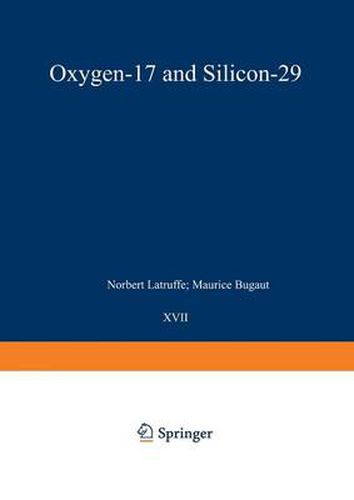Readings Newsletter
Become a Readings Member to make your shopping experience even easier.
Sign in or sign up for free!
You’re not far away from qualifying for FREE standard shipping within Australia
You’ve qualified for FREE standard shipping within Australia
The cart is loading…






This title is printed to order. This book may have been self-published. If so, we cannot guarantee the quality of the content. In the main most books will have gone through the editing process however some may not. We therefore suggest that you be aware of this before ordering this book. If in doubt check either the author or publisher’s details as we are unable to accept any returns unless they are faulty. Please contact us if you have any questions.
Although it was shown very early [1] that the isotope 29Si is very valuable for NMR research, severe technical difficulties had to be overcome before silicon spectra could be recorded. This was due to the low sensitivity of the isotope resulting from its low gyro magnetic ratio, its low abundance and the rather long relaxation times. The introduction of the Fourier-Transform-Technique (FT-NMR) helped to surmount most of these problems, with the result, that more and more papers concerning silicon NMR appear. Thus, it seems now that most of the salient features of 29Si-NMR are known today. Some resume of the state of the art of 29Si_NMR have been reported [1-4]. Although the theory of 29Si-NMR is not yet understood beyond the basic features, it promises to be of value mainly for two reasons: 1. Silicon is strategically located in the Periodic Table of the elements between the elements carbon, aluminum and phosphorus. For an unified theory of chemical shifts and coupling constants of the heavier elements silicon NMR values will be important. 2. The normal coordination number of silicon is four. If the current view of the chemical shifts of the heavier elements is correct, then the paramagnetic part is dominant for the measured shift data. Two of the parameters used for the calcu lation of the paramagnetic part are bond orders and angles. Bond angles are rare ly determined experimentally with high precision.
$9.00 standard shipping within Australia
FREE standard shipping within Australia for orders over $100.00
Express & International shipping calculated at checkout
This title is printed to order. This book may have been self-published. If so, we cannot guarantee the quality of the content. In the main most books will have gone through the editing process however some may not. We therefore suggest that you be aware of this before ordering this book. If in doubt check either the author or publisher’s details as we are unable to accept any returns unless they are faulty. Please contact us if you have any questions.
Although it was shown very early [1] that the isotope 29Si is very valuable for NMR research, severe technical difficulties had to be overcome before silicon spectra could be recorded. This was due to the low sensitivity of the isotope resulting from its low gyro magnetic ratio, its low abundance and the rather long relaxation times. The introduction of the Fourier-Transform-Technique (FT-NMR) helped to surmount most of these problems, with the result, that more and more papers concerning silicon NMR appear. Thus, it seems now that most of the salient features of 29Si-NMR are known today. Some resume of the state of the art of 29Si_NMR have been reported [1-4]. Although the theory of 29Si-NMR is not yet understood beyond the basic features, it promises to be of value mainly for two reasons: 1. Silicon is strategically located in the Periodic Table of the elements between the elements carbon, aluminum and phosphorus. For an unified theory of chemical shifts and coupling constants of the heavier elements silicon NMR values will be important. 2. The normal coordination number of silicon is four. If the current view of the chemical shifts of the heavier elements is correct, then the paramagnetic part is dominant for the measured shift data. Two of the parameters used for the calcu lation of the paramagnetic part are bond orders and angles. Bond angles are rare ly determined experimentally with high precision.